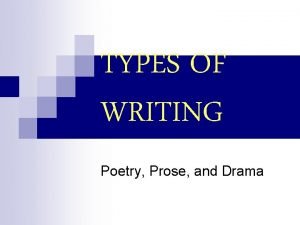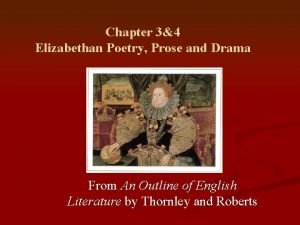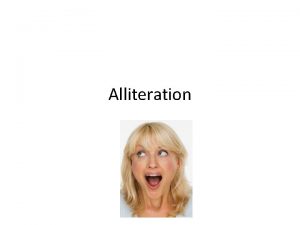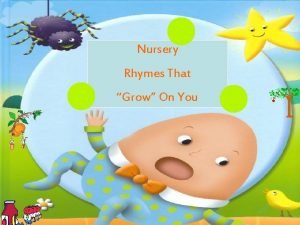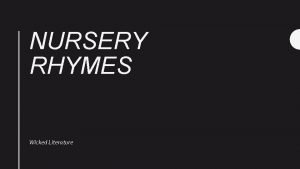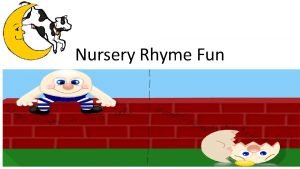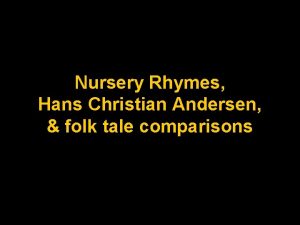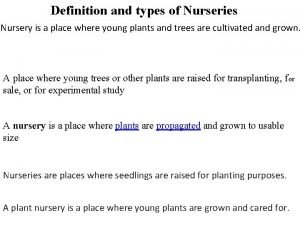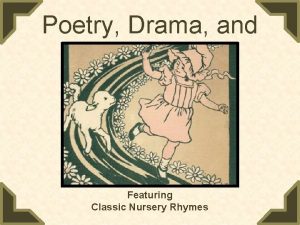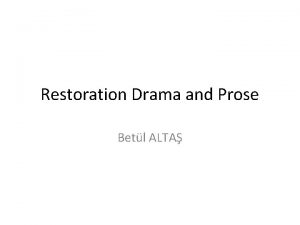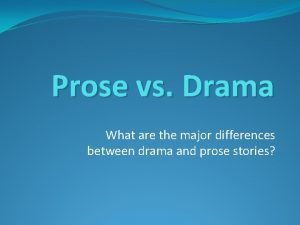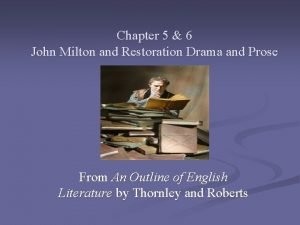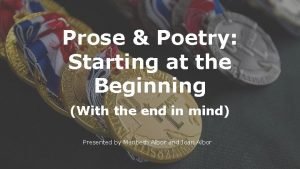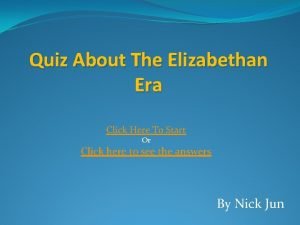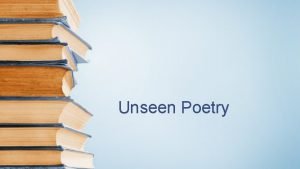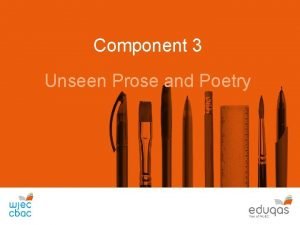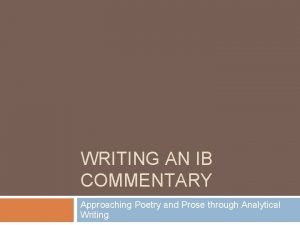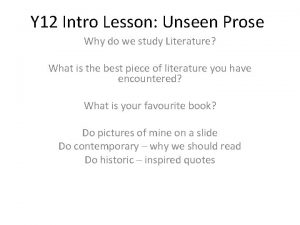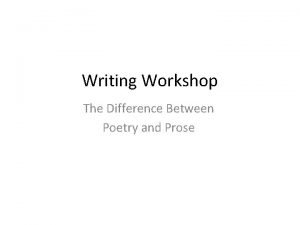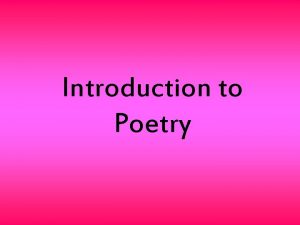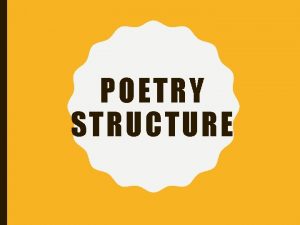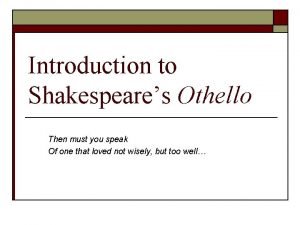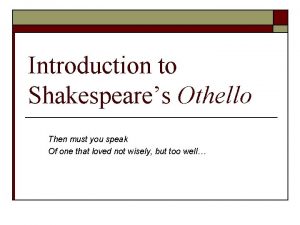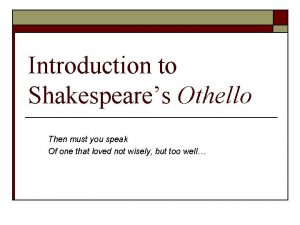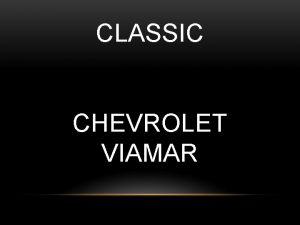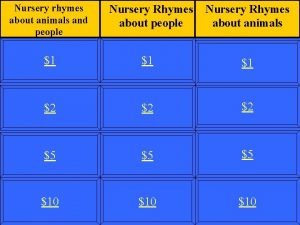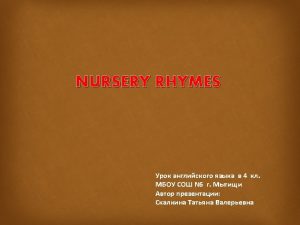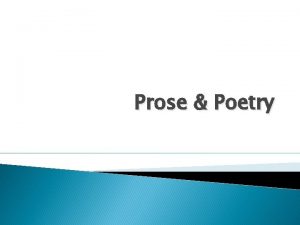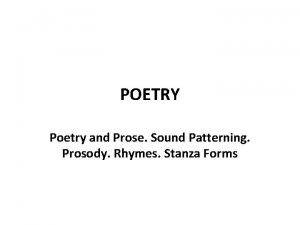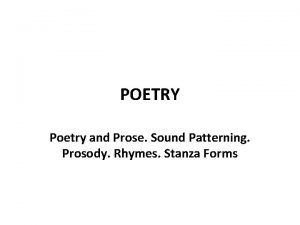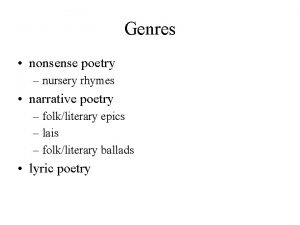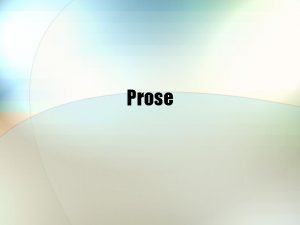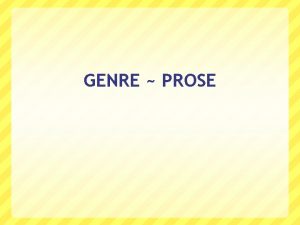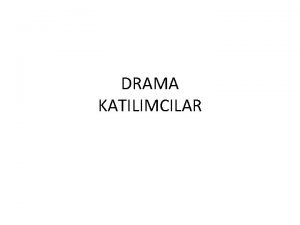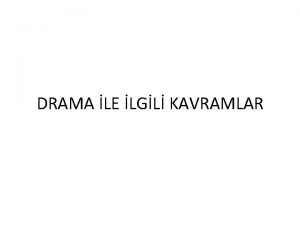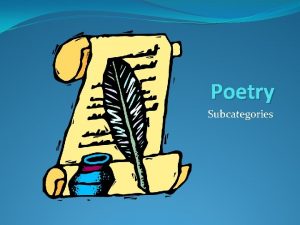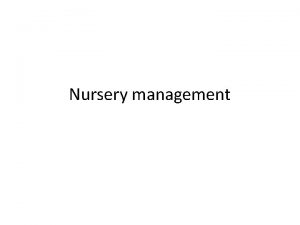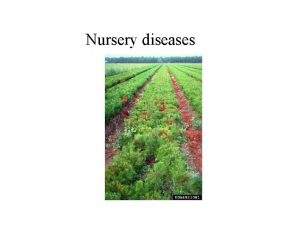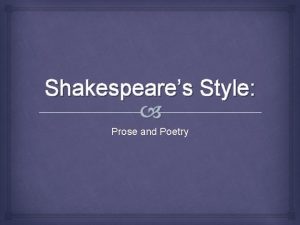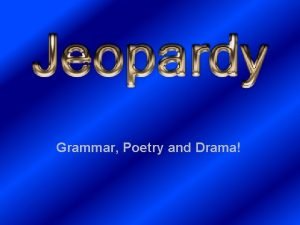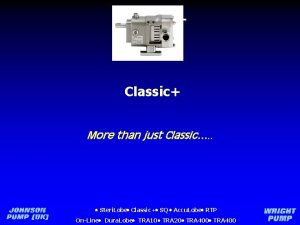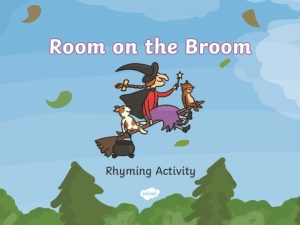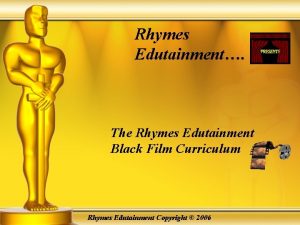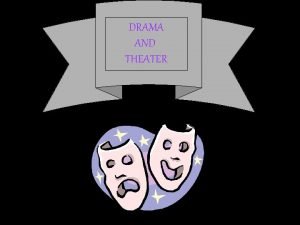Poetry Drama and Prose Featuring Classic Nursery Rhymes






















![Stage Directions Some stage directions tell what the actors should do. TEACHER [sternly]: Mary, Stage Directions Some stage directions tell what the actors should do. TEACHER [sternly]: Mary,](https://slidetodoc.com/presentation_image/29ecc836243491eed90ec47acd8d2d55/image-23.jpg)







- Slides: 30

Poetry, Drama, and Prose Featuring Classic Nursery Rhymes

POETRY

What Is Poetry? • Poetry is an expressive form of writing. It allows the author to share an idea or insight with others in a meaningful way. • Poetry is not written in sentences and paragraphs like prose. Instead, It uses different structures that make it interesting to read.

• Structural Elements of Poetry Verse – one line of poetry • Stanza – group of verses • Rhythm – beats or accented syllables • Meter – pattern of beats or accented syllables • Rhyme – syllables that sound similar

Verses and Stanzas Each line of poetry is called a verse. Verses are grouped into stanzas. Mary had a little lamb. Its fleece was white as snow. And everywhere that Mary went, The lamb was sure to go. How many verses are in the first stanza of “Mary Had a Little Lamb”? Right! This poem has four verses, or lines, per stanza.

Verses and Stanzas Mary had a little lamb. Its fleece was white as snow. And everywhere that Mary went, The lamb was sure to go. And so the teacher turned it out, But it still lingered near, And waited patiently about, Till Mary did appear. He followed her to school one day, Which was against the rule, It made the children laugh and play To see a lamb at school. “Why does the lamb love Mary so? ” The eager children cry. “Why, Mary loves the lamb, you know. ” The teacher did reply. How many stanzas are in “Mary Had a Little Lamb”? Right! It has four stanzas.

Rhythm means beat. Let’s find the beat in these lines of poetry. Clap each stressed syllable as the poem is read. Mary had a little lamb. Its fleece was white as snow. And everywhere that Mary went, The lamb was sure to go. Now let’s highlight the accented syllables as we read the poem aloud together. You can see that every other syllable is accented. This is the poem’s rhythm.

Meter describes the arrangement of the rhythm. Here you can see the meter for “Mary Had a Little Lamb. ” Mary had a little lamb. Its fleece was white as snow. And everywhere that Mary went, The lamb was sure to go. How can you describe the meter of this poem? The first line has four beats, the second line has three, the third line has four, and the fourth line has three. We’ll say it has a meter that is 4 -3 -4 -3.

Rhyme happens when the sound of the last syllable(s) of a verse sound like the last syllable(s) of another verse. Mary had a little lamb. a Its fleece was white as snow. b And everywhere that Mary went c The lamb was sure to go. b Here, snow rhymes with go. We give a letter to each verse. Rhyming words get the same letter. This poem has an abcb rhyming pattern. The b’s represent snow and go because they rhyme.

More Practice Twinkle, twinkle, little star, How I wonder what you are. Up above the world so high, Like a diamond in the sky. Clap out the rhythm. Each verse has four beats. a a b b What about the rhyming pattern? Yes, star and are rhyme, and high and sky rhyme. The pattern is aabb.

More Practice Baa, black sheep, Have you any wool? Yes sir, yes sir, Three bags full. How many beats are in each verse? This poem’s meter is 4 -3 -4 -3. The first and third lines have four beats, and the second and fourth lines have three. Can you name the rhyming pattern? Right. It would be abcb. The second and fourth lines rhyme, but the first and third do not.

PROSE

What Is Prose? • Prose is ordinary language. • Prose is written in sentences and paragraphs that may include dialogue. • Most of the literature we read is written in prose.

• Structural Elements of Prose Sentence – group of words that express a complete thought • Paragraph - sentences that are grouped together • Dialogue – words or sentences that quote what a person has said

Sentences A sentence is a group of words that express a complete thought. As Mary was coming home, she heard a strange little patter, patter behind her. A sentence begins with a capital letter and ends with a period, question mark, or exclamation point.

Paragraphs Sentences that are grouped together are called a paragraph. As Mary was coming home, she heard a strange little patter, patter behind her. She looked back and saw something white! Mary felt a wee bit afraid and began to run, but her foot struck a rock, and down she tumbled. Before she could get up, something soft and wooly was rubbing gently against her. A paragraph is indented.

Dialogue tells the speaker’s exact words. “Oh, you darling lamb!” cried Mary, hugging it. The lamb snuggled close. Dialogue is also indented. The speaker’s words are placed in quotation marks. A dialogue tag (cried Mary) tells who said it. Other text may be placed in a paragraph with dialogue.

DRAMA

What Is Drama? • Drama can also be called a play. • In its written form, a play includes a cast of characters, dialogue, and stage directions. • Drama may be organized in scenes and acts.

• Structural Elements of Cast of Characters - list. Drama of characters in play • Dialogue – words that tell the actors what to say • Stage Directions – words that tell how the stage should look or what the actors should do • Setting - words that tell where and when a play takes place • Scenes - sections of the play with similar setting • Acts - major sections of a long play

Cast of Characters A cast of characters is a list of the characters in a play. Mary Had a Little Lamb Cast of Characters Mary Lamb Mother Father Teacher

Dialogue tells the exact words the actors should say. TEACHER: Mary, what is seven times three? MARY: What? The character’s name is placed at the beginning, followed by a colon. The words that follow the colon are spoken by the actor. No quotation marks are used.
![Stage Directions Some stage directions tell what the actors should do TEACHER sternly Mary Stage Directions Some stage directions tell what the actors should do. TEACHER [sternly]: Mary,](https://slidetodoc.com/presentation_image/29ecc836243491eed90ec47acd8d2d55/image-23.jpg)
Stage Directions Some stage directions tell what the actors should do. TEACHER [sternly]: Mary, what is seven times three? MARY [jumping up]: What? Stage directions are often written in italics and surrounded by parentheses or brackets.

Setting The author may include the setting (where and when the play takes place) in the stage directions. Scene 3: The Lamb Goes to School [On a warm, sunny day, Mary gazes dreamily out the window of the old schoolhouse. ]

Scenes and Acts A play may be broken into scenes and acts. Mary Had a Little Lamb Act 1 Scene 1: Mary Meets the Lamb Scene 2: Mary Washes the Lamb Scene 3: The Lamb Goes to School Scene 4: The Lamb’s Diet Act 2 Scene 5: How the Lamb Wouldn’t Jump Scene 6: The Lamb Goes Boating Scene 7: The Lamb Wins a Prize

REVIEW

Let’s Review • Prose is ordinary language. It’s written in sentences and paragraphs, and dialogue is placed in quotation marks. • Drama is a play. It may be organized in scenes and acts. Dialogue is not placed in quotation marks; instead, the character’s name is placed before the words an actor should say. Stage directions provide information about how the stage should look and how actors should act. • Poetry is expressive writing. It is written in verses and stanzas. Poems are characterized by rhythm (beat) and rhyme (syllables that sound alike).

• Structural Elements of Poetry Verse – one line of poetry • Stanza – group of verses • Rhythm – beats or accented syllables • Meter – pattern of beats or accented syllables • Rhyme – syllables that sound similar

• Structural Elements of Prose Sentence – group of words that express a complete thought • Paragraph - sentences that are grouped together • Dialogue – words or sentences that quote what a person has said

• Structural Elements of Cast of Characters - list. Drama of characters in play • Dialogue – words that tell the actors what to say • Stage Directions – words that tell how the stage should look or what the actors should do • Setting - words that tell where and when a play takes place • Scenes - sections of the play with similar setting • Acts - major sections of a long play
 Nonsensical poem
Nonsensical poem Elizabethan age poetry drama prose
Elizabethan age poetry drama prose Nursery rhymes importance
Nursery rhymes importance Nursery rhymes with alliteration
Nursery rhymes with alliteration Rhymes with grow
Rhymes with grow Wicked nursery rhymes
Wicked nursery rhymes Potty training nursery rhymes
Potty training nursery rhymes Nursery rhymes lyrics pdf
Nursery rhymes lyrics pdf Rhymes with tale
Rhymes with tale Nursery def
Nursery def Rhymes with drama
Rhymes with drama Restoration drama and prose
Restoration drama and prose Difference between prose and drama
Difference between prose and drama Restoration drama and prose
Restoration drama and prose Example of prose
Example of prose Quiz 1 elizabethan poetry
Quiz 1 elizabethan poetry What is unseen prose and poetry
What is unseen prose and poetry Hebrew poetry structure
Hebrew poetry structure Elizabethan poetry and prose
Elizabethan poetry and prose Introduction to unseen prose
Introduction to unseen prose Prose commentary example
Prose commentary example Introduction to unseen prose
Introduction to unseen prose Success acrostic
Success acrostic If a round analog clock featuring numbers 1-12
If a round analog clock featuring numbers 1-12 Deng xioping
Deng xioping Poem vs prose
Poem vs prose Identical rhyme examples
Identical rhyme examples What makes poetry different than prose?
What makes poetry different than prose? Iambic pentameter othello
Iambic pentameter othello Then must you speak of one that loved
Then must you speak of one that loved Then must you speak of one that loved
Then must you speak of one that loved
